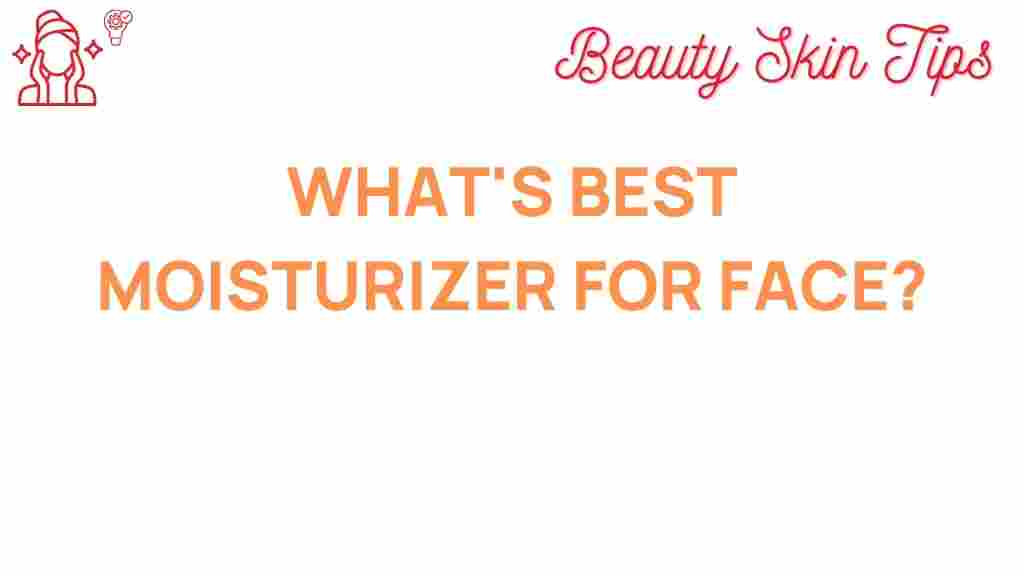Unveiling the Secret: What’s the Best Moisturizer for Your Face?
When it comes to skincare, one product reigns supreme: the moisturizer. Understanding the best moisturizer for your face can transform your skincare routine, ensuring your skin remains hydrated, youthful, and radiant. With countless options available in the market, how do you choose the right one? In this article, we will delve into the secrets of finding the best moisturizer tailored to your individual needs.
Why is Moisturizer Important?
Moisturizers play a critical role in maintaining healthy skin. They help to:
- Retain moisture
- Protect the skin barrier
- Reduce the appearance of fine lines and wrinkles
- Improve skin texture
- Prevent dryness and irritation
Using a moisturizer daily can significantly enhance your skin’s overall appearance and health. But with so many types of moisturizers available, identifying the best one for your skin type is essential.
Understanding Your Skin Type
Before selecting a moisturizer, it’s vital to understand your skin type. Here are the main categories:
- Normal Skin: Balanced, not too oily or dry, with few imperfections.
- Dry Skin: Flaky, rough, or itchy, often requiring more hydration.
- Oily Skin: Shiny, prone to acne and enlarged pores.
- Combination Skin: A mix of dry and oily areas, often with an oily T-zone.
- Sensitive Skin: Easily irritated, may react to certain products.
Identifying your skin type is the first step in choosing the right moisturizer. Now, let’s explore the different types of moisturizers available.
Types of Moisturizers
Moisturizers can be categorized into several types, each catering to different skin needs:
- Creams: Thick, rich formulations ideal for dry skin.
- Lotions: Lighter than creams, perfect for normal to slightly dry skin.
- Gels: Lightweight and absorb quickly, great for oily skin.
- Ointments: Heavy and greasy, suitable for very dry or sensitive skin.
- Serums: Concentrated formulas often containing active ingredients for targeted treatment.
Choosing the right type of moisturizer is crucial for achieving the best results. A cream may be too heavy for oily skin, while a gel might not provide enough hydration for dry skin.
Key Ingredients to Look For
When selecting a moisturizer, pay attention to the ingredients. Here are some beneficial components to consider:
- Hyaluronic Acid: A powerful humectant that attracts moisture.
- Glycerin: Another humectant that helps retain moisture in the skin.
- Ceramides: Help to strengthen the skin barrier and retain moisture.
- Shea Butter: A rich emollient that provides intense hydration.
- Vitamin E: An antioxidant that helps protect the skin.
Look for moisturizers that contain these ingredients, especially if you have dry or sensitive skin. Avoid products with alcohol or fragrances, which can irritate the skin.
Step-by-Step Process to Find the Best Moisturizer
Here’s a simple guide to help you find the perfect moisturizer for your face:
- Determine Your Skin Type: Analyze your skin to identify whether it is normal, dry, oily, combination, or sensitive.
- Identify Your Skin Concerns: Consider specific issues like acne, aging, or redness.
- Research Ingredients: Look for products that contain beneficial ingredients suited to your skin type.
- Read Reviews: Check customer reviews and ratings to gauge product effectiveness.
- Patch Test: Always conduct a patch test before fully applying a new product to avoid adverse reactions.
- Consult a Dermatologist: If you’re unsure, consulting a skincare professional can provide personalized recommendations.
Moisturizer Application Tips
Once you have chosen the best moisturizer for your face, applying it correctly can enhance its effectiveness:
- Cleanse: Always start with a clean face.
- Apply on Damp Skin: Applying moisturizer on slightly damp skin helps lock in extra moisture.
- Use the Right Amount: A pea-sized amount is typically sufficient for the entire face.
- Gentle Massage: Use upward circular motions to apply the moisturizer, promoting absorption.
- Don’t Forget Your Neck: Extend the application to your neck and décolletage area.
Following these steps will ensure that your skin receives the maximum benefit from your moisturizer.
Common Moisturizer Mistakes to Avoid
Even with the best intentions, common mistakes can hinder your skincare efforts. Here are some pitfalls to watch out for:
- Over-Moisturizing: Applying too much product can clog pores, especially for oily skin types.
- Ignoring the Ingredients: Not paying attention to harmful ingredients can lead to breakouts or irritation.
- Skipping Daytime Moisturizer: Always use a moisturizer, even during the day, to maintain hydration.
- Neglecting Sunscreen: Always apply sunscreen as the last step in your morning routine, even if your moisturizer contains SPF.
Troubleshooting Tips for Moisturizer Issues
If you encounter issues with your moisturizer, consider these troubleshooting tips:
- Dry Skin: If your skin still feels dry, look for a richer formula or apply a hydrating serum underneath.
- Oily Skin: If your skin feels greasy, switch to a gel-based moisturizer or reduce the amount used.
- Breakouts: If you experience breakouts, check for comedogenic ingredients and try a non-comedogenic moisturizer.
- Irritation: If your skin becomes red or irritated, discontinue use and consult a dermatologist.
Remember, skincare is a personal journey, and finding the right moisturizer may take some time and experimentation.
Conclusion
Choosing the best moisturizer for your face is essential for maintaining healthy, hydrated skin. By understanding your skin type, researching ingredients, and applying the product correctly, you can unveil the secret to radiant skin. Always remember that skincare products work differently for everyone; what works for one person may not work for another. If in doubt, seek professional advice from a dermatologist.
For more skincare tips and product recommendations, check out this comprehensive guide. And remember, the journey to great skin begins with the right moisturizer!
For further information on skincare routines, visit this resource.
This article is in the category Skincare and created by BeautySkinTips Team
